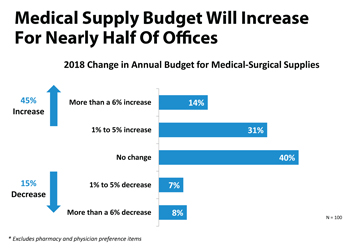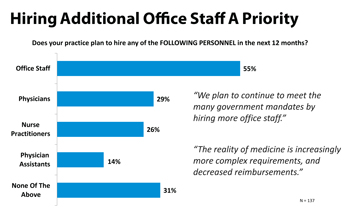Financial concerns continue to be a leading challenge for physician
practices. Thirty-five percent of physician office managers list
reimbursement as a top concern, while a sizeable portion identify
collecting co-payment and deductibles (30 percent) and lowering
operating costs (21 percent) as priorities. These needs are shaping
provider priorities, and inform decisions physician practices make.
HIDA’s provider survey The Evolving Physician Office: Revenue Pressure Determines Practice contains
an in-depth look at the financial pressures these providers face, as
well as the steps physicians are taking to address them. These are just a
few insights from the report.

Aging population drives up medical supply budgets
Forty-five percent of physician offices plan to spend more on
medical supplies, with 14 percent planning to increase their budgets by
more than 6 percent. Key drivers of this trend include greater patient
volume due to an aging population, higher costs, and a greater incidence
of chronic conditions.
Physicians increase on-site offerings
Thirty-five percent of physician offices provide at least
moderately complex clinical lab testing on site, an eight percentage
point increase from 2016. Among the providers that do not provide
on-site lab testing, 35 percent said that regulations are too
burdensome, and 27 percent said reimbursement is not adequate.
Providers invest in technology, staff to strengthen reimbursements
Survey respondents discussed a number of investments they plan
to make to improve their revenue cycle. Examples of this include credit
and debit card systems, so patients can be charged at the time of
service, and new technology to determine what a patient’s deductible
will be at the time of service. One practice manager added that they are
training front desk personnel on professional collection strategies.

Staffing remains a priority
Staffing remains a key priority for physician office practices,
although the majority (55 percent) are focused on hiring non-clinical
office staff. Less than one-third (29 percent) plan to hire physicians,
while 26 percent plan to hire nurse practitioners, and 14 percent are
recruiting physician assistants.
Larger physician practices tend to employ more non-physician clinical
staff, such as nurse practitioners and physician assistants. Practices
with 11 or more physicians have, on average, five nurse practitioners
and two physician assistants. By comparison, offices with two to five
physicians employ a single physician assistant and two nurse
practitioners.
These are just some of the insights contained in the provider survey.
For more information, or to learn about HIDA’s primary research, visit www.HIDA.org/ProviderSurvey.
From: http://www.repertoiremag.com/rising-costs-revenue-pressures-shape-physician-practice-priorities.html